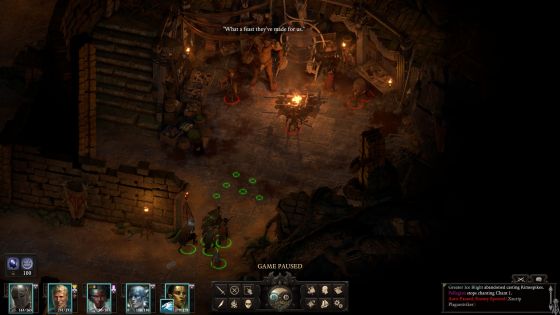Pillars of Eternity 2: Deadfire Review

In 2012, Obsidian Entertainment announced that they were working on a game similar to the Baldur's Gate games. Fans were hyped, and the following Kickstarter campaign became the most successful campaign in video game history by obtaining roughly $4 million in funding. Three years later, Pillars of Eternity was released to critical acclaim, including in our own review by Corwin.
What's strange about Pillars of Eternity is that, while the reception, reviews and ratings were good at the time, it's still considered "good, but not great" by a lot of people, especially if played without the two DLCs, The White March part 1 and 2. This led to a mediocre reception when Pillars of Eternity 2 was announced, and the expectations weren't all that great ahead of this year's release.
They probably should have been though, as Pillars of Eternity 2 is flat out better than its predecessor in pretty much every way. After two decent attempts, Pillars of Eternity and Tyranny, it's fair to say that Obsidian Entertainment has gained considerable experience in how to make isometric, party based RPG's with the Unity engine. It shows.
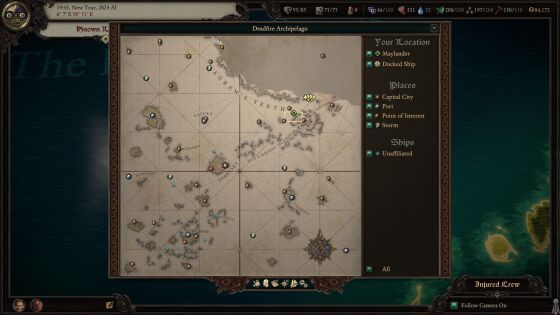
The Deadfire Archipelago is much more rewarding to explore than Dyrwood was
The game is still set to world of Eora, but the rather bleak nation of Dyrwood has been replaced by a huge, sprawling archipelago called the Deadfire Archipelago, which offers a form of exploration and atmosphere that Dyrwod simply doesn't come close to. It also shows a level of craftsmanship that is not present in either Tyranny or Pillars of Eternity.
Character development
Before exploring the Deadfire Archiplego, however, a main character must be created or imported from Pillars of Eternity 1. If you decide to import a character, a lot of major decisions will be imported, but you can still select a new class and appearance, probably because of the sweeping changes the character creation system has received.
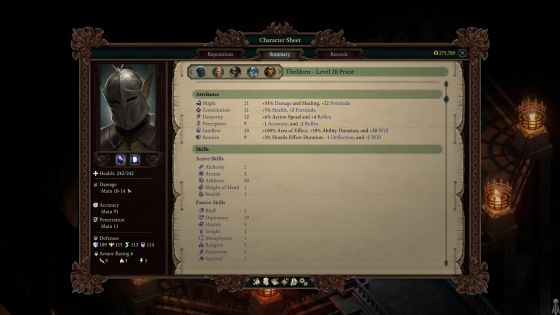
Classes, races and attributes should be familiar to people who played Pillars of Eternity 1
All classes and races from the original are still present, but they've also added multiclassing and subclassing, and even multiclassing involving subclasses. This offers a ridiculous amount of options and flexibility, to the point where it can even be considered overwhelming, which is probably why there is an in-game recommendation against multiclassing for new players.
It's certainly not because multiclassed characters aren't powerful enough, despite having a few drawbacks. The main drawback is gaining new abilites slightly slower, which also means they will never get access to level 8 and 9 abilities. Another drawback is gaining less "power level", which is basically a way of letting lower level spells remain relevant even later in the game.
However, these drawbacks are easily offset by the advantages of being able to combine the strengths of two classes, such as combining a Monk with the Druid subclass "Shapeshifter", which allows players to utilize the unarmed skills of a Monk while being shapeshifted into various animal forms. They also maintain most of their Druid spells, which means they can buff, heal and deal damage with spells if need be. Due to power level, these spells will be slightly weaker than a pure Druid, but most of the damage will come from unarmed attacks in various Shapeshifter forms.

A multiclassed character, here in the form of an Arcane Knight, which is a combination of Paladin and Mage
Another example of this is a Mage combined with a Paladin to create a tank-like killing machine who can cast a wide range of buffs to enhance the high, natural defenses of Paladins, effectively making them immortal. Such a character wouldn't even need a shield to tank, thus allowing them to go all out with two weapons and still be considerably more sturdy than most tanks.
Since all spells and abilites are now per-combat instead of per-rest, all these buffs can be cast for every fight. That would normally be quite a chore, but it's possible to set up the AI to do it for you with character specific configurations, similar to what Dragon Age offered. This basically means that every fight could potentially start off with an immortal character that can just wade through everything at will, but it requires a lot of character development planning to make it happen.

The AI script setup is rather complex. A neat little trick is to set the "Not" flag on certain buffs, and then set it up to cast that buff whenever it is not present
That sort of thing will no doubt divide the player base. Some people prefer the far more balanced approach of Pillars of Eternity 1, whereas others really enjoy experimentation and figuring out powerful combinations. Personally, I prefer the latter, and I always find it satisfying when a well planned character build comes together. Some of my most enjoyable runs in Baldur's Gate 2 involved Berserkers or Kensai dualled to Mages or Clerics, despite being vastly more powerful than most characters. A single player game doesn't have to be perfectly balanced, and it should be rewarding to put some actual thought into character progression.
Gameplay
Pillars of Eternity 2 is rather similar to its predecessor when it comes to gameplay. It's still an isometric, party based game with RTwP (Real-Time with Pause) combat, but it feels considerably smoother and more intuitive.
Spells, abilities and health are now restored after each fight, so the resting and supplies system in Pillars of Eternity 1 has been changed to a system which provides certain buffs and removes injuries the characters can gain from triggering traps and getting knocked out. This also means that the rather unintuitive endurance vs hit points system has been replaced by more traditional hit points.
The actual combat feels like a natural evolution on the combat found in White March part 2, which was already vastly superior to previous iterations. Abilities packed more of a punch, different character builds had more of an impact and enemies felt more varied. This trend continues in Pillars of Eternity 2, where even companions can be multiclassed and where the difference between a powerful build and a mediocre one can make a huge difference, especially on higher difficulty levels.
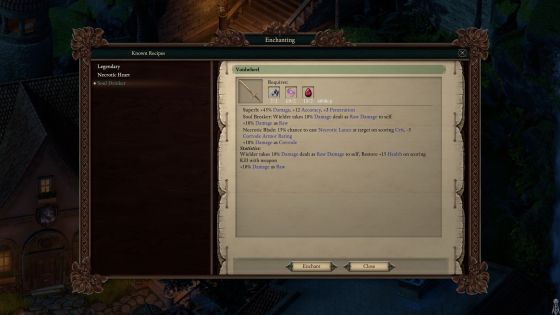
Many items have enchant options that are unique to that particular item
Crafting can also make a difference on higher difficulty levels, as most unique items can be enchanted in various ways. This differs from its predecessor in that items can now be customized by more rare enchants than simply adding fire damage and similar to a weapon, and it makes enchanting more interesting. Various consumables can also be crafted, but it's entirely optional as there doesn't appear to be a general shortage of potions and such in the Deadfire Archipelago.

The characters get one passive and one active skill point per level
It's also worth noting that not everything revolves around combat. Skills are now divided into active and passive skills, where only active skills have any impact on combat, via things like alchemy, explosives, stealth and mechanics. Passive skills, however, are used in dialogues, and will greatly affect what options are available and how certain situations can be resolved.
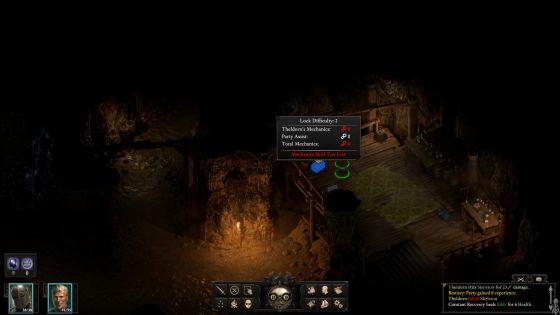
The party can provide assistance to skill checks in a lot of situations, but it doesn't simply pick the highest skill
Traditional skills like diplomacy, bluff and intimidate are complimented by more unconventional ones such as "History" and "Insight" that also open up a wide range of new dialogue options. A character can only put a single point into one active and one passive skill per level, so it's impossible to rely on one character for all events and dialogues, but the main character can be helped out by the party via the "party assist" system that yields a certain buff based on the skills of party members, though it's not a 1:1 ratio like in Tyranny.
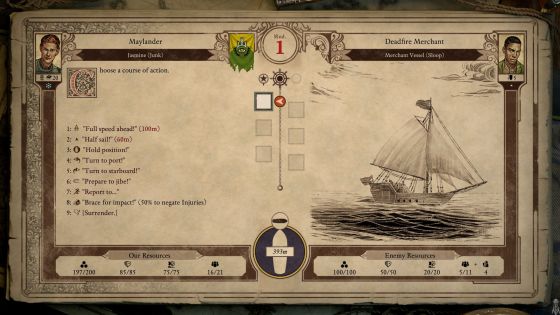
They could have skipped ship combat. The idea is nice, but they clearly didn't have time to make it interesting
The only thing that feels somewhat rushed regarding gameplay is the ship-to-ship combat, which simply feels like a chore. The system is both text- and turn-based, where the player can select whether to move, halt or fire cannons with various types of ammo. The most efficient way of handling it seems to be buying any speed related upgrades for the ship and then simply rush to the other ship to board them, which initiates a regular fight between the crews of the two ships. They genuinely could have skipped the entire text-based part and simply had the ship-to-ship boarding as encounters instead.
Overall, the gameplay has a very good feel to it though, and the ship combat plays a very minor role in the grand scheme of things. Regular combat, skills, crafting, character development and dialogues all work very well, which was not always the case in Pillars of Eternity 1.
Exploration
Pillars of Eternity 1 featured a fairly traditional exploration experience similar to Baldur's Gate, Icewind Dale and Planescape: Torment. Locations on the overland map were unlocked over time, and then the player could travel to said locations by selecting them on the map.
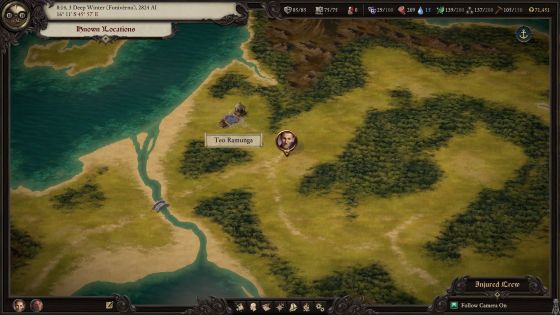
The overland map makes the world feel larger than traditional fast or instant travel maps do
Pillars of Eternity 2, however, features a map similar to Arcanum, where the player can freely explore the world on the actual overland map, discovering locations, loot, encounters and events along the way. A lot of locations, such as dungeons, can be explored by the party, while others simply yield text-based events, small puzzles and similar, and are mainly there for the flavor.
Early on, the player is granted access to a ship, which can be upgraded in certain ways and acts as a base of operations. The actual ship mechanics are somewhat lacking, but the exploration itself is not: The Deadfire Archipelago feels much bigger and more alive than Dyrwood ever did. It also has a completely different atmosphere; it's brighter, more beautiful and with a musical score that sets a really good tone.
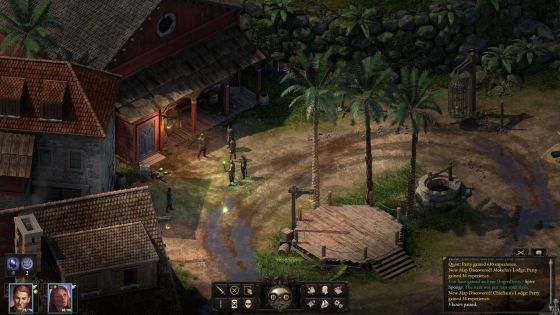
The atmosphere is fantastic in a lot of locations
While the setting itself is bright and beautiful, some of the underlying conflicts are not: The Deadfire Archipelago is contested territory, with a number of factions vying for control over its lush lands. These factions play a vital role in the overall story, and range from natives to colonists and pirates. Being close to one or more of them grants access to special items, additional quests and even unique ways of solving quests that are seemingly unrelated to the factions.
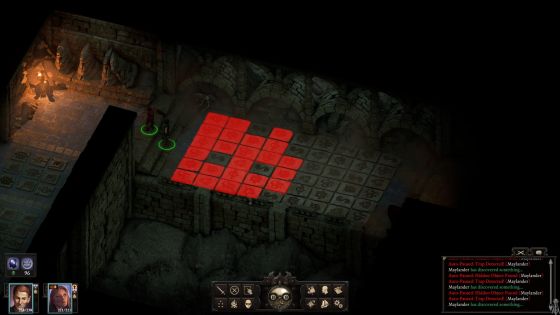
There are a lot of puzzles and traps to be found, though most are fairly straight forward to deal with
The quests themselves are scattered across the world, and the vast majority of them are optional, so there is a strong emphasis on exploration. This emphasis is also seen in how loot is handled: Loot is hand placed, and a lot of the more unique items are found in the far corners of the world, usually behind some puzzle, quest or challenging encounter.
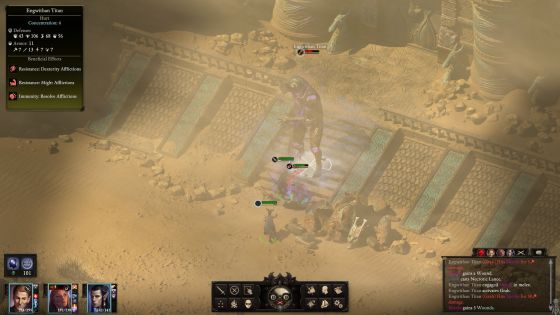
The Deadfire Archipelago consists of more than just tropical rainforests
Exploration is heavily encouraged in Pillars of Eternity 2, and for good reason, as Obsidian has clearly put a lot of effort into creating the Deadfire Archipelago. As a result, the locations are well worth exploring; they are beautiful, interesting and very detailed. Certain smaller areas feel a bit cramped, but the bigger ones feel excellent, and the biggest city in the game is similar to Athkatla from Baldur's Gate 2 in size and scope.
Writing
Most RPG fans who have been around for a while know roughly what to expect when it comes to Obsidian and writing: There are interesting characters and companions, a somewhat pompous main quest and a wide range of side quests that can be solved in many different ways.
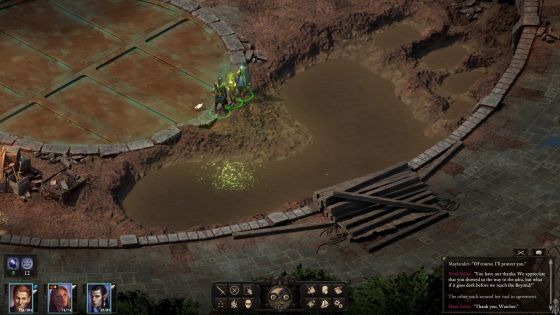
Rather large footprint. Maybe it's not too late to turn back?
Still, compared to its predecessor, Pillars of Eternity 2 has a much lighter tone overall, and the Deadfire Archipelago is a significantly less depressing place than Dyrwood. It's certainly not part of the "dark and gritty" trend, which is a welcome change for those of us who feel that particular trend has grown a bit stale at this point.
Another welcome change is a stronger focus on politics. Politics in games is usually rather black and white, whereas real politics is muddled water to say the least. Pillars of Eternity 2 is somewhere in the middle; it's certainly not as nuanced as actual politics, but it's certainly more interesting than what most games have to offer.
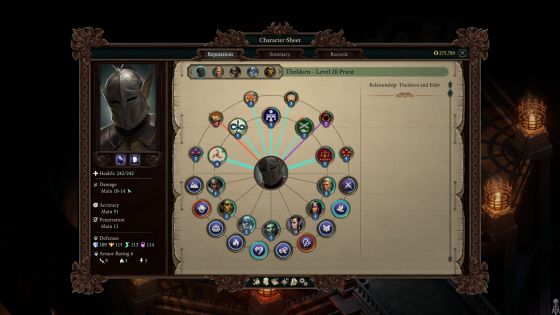
There are a lot of factions and characters to gain or lose reputation with
This focus also affects characters, as a lot of characters either have personal agendas or are tied to some faction with an agenda. Even companions have their own opinions on political matters, and agreeing or disagreeing with them raises or lowers their opinion of the main character. This generally only leads to a few unique dialogues from time to time, but in some rare cases choosing one faction over another can actually cause specific companions to leave the party permanently.
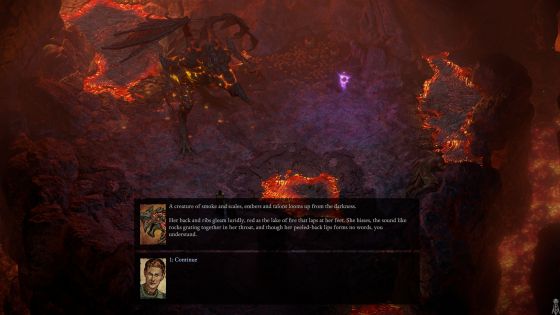
This sort of situation would automatically lead to a fight in most games, but that might not be the case here
Most choices and consequences aren't anywhere near as brutal as that, of course, but they are present in almost every quest and intereaction. In fact, given the sheer amount of choices, it's somewhat surprising that there aren't more bugs to be found: Having a lot of choices and consequences in a game makes it very hard to test everything properly, which is why most such games tend to have a fairly high number of quest related bugs, for example quests that can't be completed. That's rarely the case in Pillars of Eternity 2, which is quite impressive.
Verdict
Pillars of Eternity 2 features a much better setting than the original, much more complex character development and production values only rivaled by Divinity: Original Sin 2 among isometric, party based games. It's also worth noting that the intro of Pillars of Eternity 2 does a fairly good job of summarizing the events of its predecessor, so there's no real need to remember or even play it prior to starting Pillars of Eternity 2.
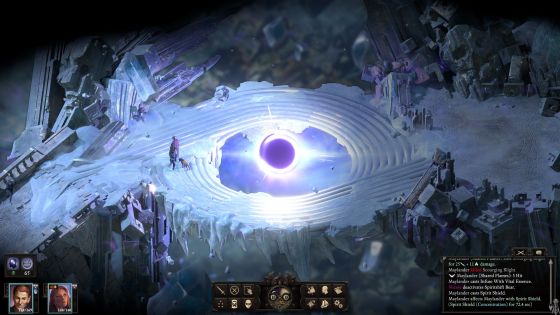
Pillars of Eternity 2 is a genuinely beautiful game most of the time
All in all, that makes it an easy game to review. It's simply a better game than Pillars of Eternity 1 in every way, so it is obviously recommended to anyone who enjoyed the original. Even those who found the original somewhat mediocre or who are on the fense should probably take a look given how much of an improvement it is.
Of course, people who aren't fans of isometric, party-based games or games with RTwP (Real-Time with Pause) combat aren't likely to enjoy Pillars of Eternity 2, as it doesn't really do anything to change established rules and formulas. For the rest of us, however, it is an excellent RPG that is well worth playing.
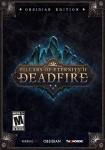
Information about
Pillars of Eternity II: DeadfireDeveloper: Obsidian Entertainment
SP/MP: Single-player
Setting: Fantasy
Genre: RPG
Combat: Pausable Real-time
Play-time: Unknown
Voice-acting: Unknown
Regions & platforms
Internet
· Platform: PC
· Released: 2018-05-08
· Publisher: Versus Evil
More information
Summary
Pros
- Excellent character development
- A lot of choices and consequences
- Beautiful world with a great atmosphere
- Interesting characters and factions
- Good exploration
Cons
- Smaller areas feel cramped
- Poor ship combat


